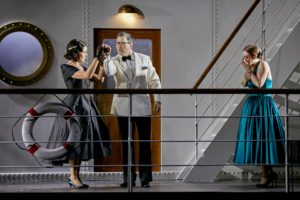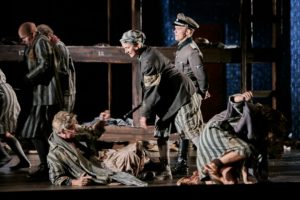Supposedly the Danes are the happiest nation in the world. They have a stable government, no problems with corruption, equal access to education and superb health care. They also have very high taxes and pay them with a big smile on their faces – convinced that an honest fiscal contribution has a positive influence on societal relations. The average Dane is involved in at least three organizations, takes care to ensure proper interpersonal relationships, is able to be content with little and enthusiastically practices the philosophy of hygge, by some compared to the Classical Chinese yin/yang concept; by others, with the French joie de vivre; by Poles – however wrongly – with any old mentality from under the banner of ‘it’ll all work out somehow’.
Wrongly, because the Danes – unlike many of our fellow countrymen – long ago abandoned dreams of power and, after numerous military defeats in the 19th century, went the route of a gentle Romantic nationalism. Guided by the wisdom of poet Hans-Peter Holst, they decided to reforge external defeat into internal victory. They occupied themselves with what had turned out most successfully in this ‘flat little country’: working the land and disseminating knowledge. Adherence to the idea of a tightly-knit community, attachment to tradition and the certainty that small is beautiful also helped them survive the difficult time of the German occupation. King Christian X manifested the independence of his homeland in a manner as modest as it was uncompromising: day after day, despite his 70 years of age and numerous health problems, he would set forth on horseback, riding through the streets of Copenhagen – in full military gear and without any bodyguards. On Rosh Hashanah, the Jewish New Year holiday, which in 1943 fell on the night of 1–2 October, when the Germans ordered a universal deportation of Danish Jews, something extraordinary happened: the Danes joined together in a masterfully-organized campaign to transfer those being persecuted to neutral Sweden. Out of a total of nearly 8000 people of Jewish origin, there were not even 600 who didn’t make it to the other side of the Baltic. Some of them hid in Denmark until the end of the war, some ended up in the Theresienstadt camp, where despite everything no less than 425 people managed to survive. The number of Danish Holocaust victims remained one of the lowest in the occupied countries of Europe. While historians have pointed out the relative logistical ease of the rescue action, above all what they have noticed is the high degree of assimilation of the Jewish community and the universal conviction among the Danes that the action aimed by the Germans against the Jews was injurious to the integrity of the entire nation. It is characteristic that most participants in the campaign chose to remain anonymous – at Yad Vashem, there is just a single tree planted in honour of the King and the Danish resistance movement, whose efforts are also symbolized by the fishing boat from the village of Gilleleje used to transport the refugees, which is on display at the exhibition.
Stefania Dovhan (Marta), Daniel Szeili (Walther) and Dorothea Spilger (Liese). Photo: Den Jyske Opera
In August 2018, the stage of Den Jyske Opera in Aarhus was graced by Mieczysław Wajnberg’s The Passenger – for the first time in Scandinavia (after the triumphant parade of Pountney’s staging through Europe and the United States, after several realizations in Germany and Thaddeus Strassberger’s shocking production in Ekaterinburg), prepared in collaboration with the Adam Mickiewicz Institute and awarded two Golden Masks in April: for conductor Oliver von Dohnányi and the performer of the role of Liese, Nadezhda Babintseva. The première, the third thus far in the Mickiewicz Institute’s POLSKA MUSIC program, took place at Musikhuset Aarhus, a concert complex seating 3600, situated in the city center and erected between 1979 and 1982 according to a design by architectural studio Kjær & Richter. Up until 1977, Den Jyske Opera put on a mere two operas annually. It got a second wind after its move to Musikhuset in 1982 and a season that began with a staging of Richard Wagner’s complete Ring cycle. In May of last year, German stage director Philipp Kochheim became general manager of the Danish National Opera. After a few productions realized back in Bonn, Kassel and Braunschweig, he decided to open the new season in Denmark with Wajnberg’s opera: written in 1968, presented in 2010 in Bregenz and shortly thereafter acknowledged as one of the most important works of music theatre in the last half century.
The success of the Danish endeavour was decided not only by artistic considerations: who knows if what won’t go into the annals of Den Jyske Opera is, first of all, the unprecedented educational campaign accompanying preparations for the Scandinavian première of The Passenger. The safe world of hygge was invaded by the trauma of the Holocaust, the memory of a Nazi death factory, a place of torture and death for political prisoners and the anti-Hitler opposition, a center for the extermination of over 1 million Jews from all over Europe. It is with this painful splinter that participants in the TalentU program – young choristers who support the regular Danish Opera ensemble – had to reckon. The 19-year-old Laurid Juul Langballe felt on her own back the weight of one of the SS uniforms sewn in the Hugo Boss AG sewing room by forced labourers employed at the camp in Metzingen. Frida Jørgensen Hvelplund and Inger Margrethe Holt Povlsen decided to shave their heads and donate their hair to make wigs for pediatric chemotherapy patients – so as to all the more consciously enter into the role of the mistreated prisoners at Auschwitz. The performer of the role of Tadeusz, young Norwegian baritone Leif Jone Ølberg, decided to play the Chaconne from Bach’s Partita no. 2 BWV 1004 without the aid of a stand-in – clumsily, out of tune, portraying powerfully for the audience the anger and pain of an artist degraded in the camp.
Eline Denice Risager (Kapo, spoken role) among the prisoners. Photo: Den Jyske Opera
Kochheim’s staging – compared to Strassberger’s brutal vision – seemed much smoother and more adapted to the sensibilities of the contemporary audience. The director toned down the contrast between the luxury of the transatlantic cruise liner and the revolting filth of Auschwitz. He needlessly emphasized the distance between the psychopathic Liese, devoid of reflective capacity, and the superhumanly good Marta – the Ekaterinburg production’s portrayal of the two protagonists as almost equal victims of the machine of oppression made a decidedly greater impression on me. He was not in total control of the performers’ acting: Liese’s hysteria, growing from the first scenes onward, took away from the credibility of both her dialogues with Walter and the half-dreamlike reminiscences from the camp intruding into the narrative. The Germans in this show are too evil; the transatlantic cruise passengers, excessively grotesque; the prisoners, too clean and unbelievably reconciled to their cruel fate. A few solutions, however, have taken a longer-term place in my memory: among other things, the brutal clang of the railing being knocked over onto the stage floor, designating the transition from the studied reality of the cruise to the dark world of Auschwitz, marked by disintegration; above all, however, the perfectly thought-out scene of Tadeusz’s rebellion, who plays out his death sentence in a circle of bullying SS men and is bade farewell by the increasingly full sound of the orchestra and the more and more desperate wailing of his beloved Marta. The finale again smacked of didacticism – the still beautiful though aged Marta meets her ugly persecutor, lost in a colourful crowd of young sightseers, at the Oświęcim station near the Auschwitz camp. The painful secret is replaced by easy journalism – perhaps justified in a country which is reckoning years later with the Holocaust nightmare contained in the opera score, but difficult to accept for Wajnberg’s fellow countrymen, who have still not been able to work through that nightmare to this day.
German mezzo-soprano Dorothea Spilger in the role of Liese took a long time to warm up, but despite this, she was not able to fully gain control over a harsh voice handled in too forceful a manner and insufficiently open in the upper register. Stefania Dovhan did a considerably better job in the role of Marta, gifted with a warm, peculiarly ‘Eastern’-sounding and very flexible soprano that I would enjoy hearing in one of Janaček’s or Martinů’s operas. Leif Jone Ølberg (Tadeusz) has at his disposal a baritone of uncommon beauty, but still not very big and sometimes lacking in overtones. Daniel Szeili did a solid job in the role of Walther; distinctive episodic roles were created by Tanja Kristine Kuhn (Katia), Anette Dahl (Old Woman) and Bolette Bruno Hansen (Bronka). Christopher Lichtenstein took the whole opera at quite blistering tempi, sometimes losing the character of Wajnberg’s allusions to folklore and Polish early music, but making up for this deficiency with exceptional subtlety in the vocal ensembles, especially in the intimate scenery of the women’s barracks.
Leif Jone Ølberg (Tadeusz). Photo: Den Jyske Opera
The last showing in Aarhus was rewarded with a lengthy standing ovation. I joined in with the bravos with a clear conscience – less moved by the general artistic level of the show than by having observed the fascinating process of working through trauma via art. Rarely do I have to do with musicians for whom opera is a liminal experience comparable to a catharsis, a passage into the world of wise maturity. For these young people, an awareness that ‘it will all work out somehow’ is not enough. They truly empathize with the victims of Auschwitz – they want to light a candle for them, press a cup of hot coffee into numb hands, provide them with hygge in the hereafter.
Translated by: Karol Thornton-Remiszewski



